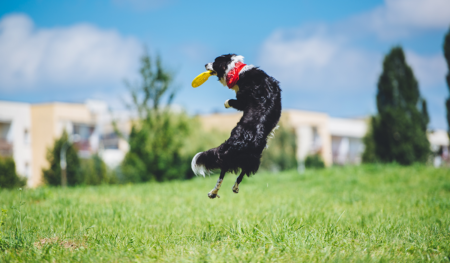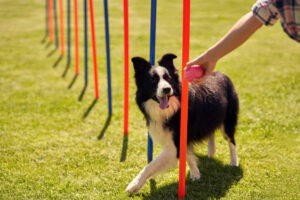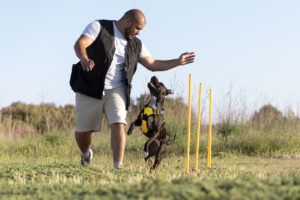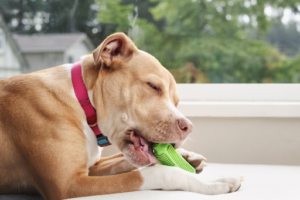If you want a great dog, there are important things you must do. A perfect dog isn’t born perfect. They become great through training and having a caring and consistent leader. The main work in making a dog great is on you, the owner. Your dog doesn’t have to do anything except follow your lead. So, what can you do every day to make sure your dog sees you as their leader? First, training is key. Spend time on how dog training exercises behave well. Be calm and patient, and always use positive reinforcement when they do something good. Consistency is also important. Stick to the rules you set for your dog every day. This helps them understand what you expect from them.
By following these steps every day, you can help shape your dog into the perfect companion,
Threshold Manners
It might signify going from their crate to entering the room, or it could refer to a gateway within the house or an entrance/exit to the outside world. It would also cover the car and gates when you are out and about taking walks.
Many individuals consider best exercise for dogs to be completely unnecessary or only “nice to have”; they don’t mind if their dog enters rooms before them or if they become excited and dash across thresholds. But this straightforward part of training makes sure you are in charge of and regulating your dog’s surroundings. Which teaches them that you are the boss and in charge of the circumstance, and that they should back off. As a result, they become less stressed and anxious and are more likely to turn to you for advice.
Food Drills For Dogs
A dog’s relationship with you can be greatly improved by educating them that food is the most valuable resource in their life. They can only obtain it by working with you or by simply obeying you and showing respect. By limiting their access to food and rewards, you are teaching them that the greatest thing in the world. Like food comes from you and that all they have to do to get it is be composed, behave nicely, and look to you for direction. From a training perspective, there are two ways you can handle the relationship between you, your dog and food.
This is a wonderful way to start working with a new dog, or even a dog you’ve had for longer. But are planning on going back to basics to help establish a calm and consistent leadership relationship with them. At the end of the day, simply tip out whatever is left of the measured food and feed it to them as usual. If you are at a point where you’re happy with your relationship with your dog, they are calm around you and look to you for guidance, demonstrate respect, listen to your verbal cues and actively seek your rewards then you may wish to revert to a more standard feeding regime. Depending on your dog’s age, breed, size and health requirements this may be one, two or three meals a day.
Food Drills For Dogs
The one thing we always try to instil in our clients is that you must never leave food down for your dog. Try to ensure they are being fed at set times every day and that this falls after they have been exercised. Ask your dog to sit and wait before presenting them with their food. Some dogs will eat their food in one go, whilst others will pick at it, wander off and come back to it later.
It’s important that best exercise for dogs as a reward, and doesn’t treat mealtimes as a buffet they can graze their way through. With this in mind, it’s vital you pick their food up after a short period of time. Remembering that every dog is different, we firmly believe 15 minutes is ample for any dog to have access to their food. If they haven’t finished eating, but have walked away, after your allotted time period, pick the food up and return it to the daily allowance. In this way, your dog is not being deprived of food, but they do not have open access to it. You can continue to use it to reward them for good behaviour or training throughout the day.
Threshold Manners
It may be the case that you do not want to keep your dog in a crate during the day, or even at night; however, there are situations where it may be impossible to avoid keeping them in one. At some point, your dog may need to stay at the vets, whether this is for a routine operation such as neutering or for an emergency procedure.
If your dog has not been exposed to crates, and offered the opportunity to welcome a crate, the entire experience is going to be far more distressing for them than is necessary. In our opinion, failing to teach your dog that crates are a positive experience is setting them up for potential anxiety and stress down the road. Taking the time to introduce a crate in a calm, loving and supportive way, even if you do not ultimately intend to use one on a daily basis, is a responsibility all dog owners should take seriously.
A crate is also a great training tool if you find yourself having to encourage your dog to calm down. They may be excitable when visitors arrive, or boisterous when children are playing in a room. If you have multiple dogs, feeding times may be problematic if there are issues with resource guarding, and a crate is a great way to overcome this in a safe way.
Exercise
Whilst all dogs are different, every single one of them will have mental and physical stimulation needs. It’s important that for the dog training exercises and wellbeing of your dog you meet those needs by providing stimulation in the form of games , as well as allowing them to exercise through walks and exploring their environment. A tired dog is a better-behaved dog and is often easier to train as a result. We always advise our clients to ensure they understand the specific needs of their dog, by taking into account their age, health, environment and breed.
Remember, something is better than nothing. If you legitimately only have time to take your dog for a 10-minute walk around the block one day, do it. It’s not ideal, but it’s better than doing nothing. Just avoid getting into the habit of doing this, and always taking them on the same route. Exploring their environment is a great mentally stimulating experience for your dog. But going over the same areas, with the same sights, sounds and smells will quickly become boring. Offer variety to keep your dog entertained and happy.
Obedience Training
For some owners, one of the many joys associated with having the best exercise for dogs is the opportunity to teach them tricks. Whilst having a dog who gives paws, spins or begs may be entertaining for you, your children or friends. In our experience many will focus on these “tricks” rather than the basics when it comes to obedience.
In order to have a well-mannered, calm and under control canine, it’s vital they are taught the following commands:
- Sit
- Stay
- Break
- Heel
- Recall
- Place
These are the six basic commands every dog should know, and every owner should utilise in order to control the vast majority of unwanted canine behaviours.
The Bottom Line
When dog training exercises understand what you expect from them, they feel less anxious. This makes them happy and secure in their relationship with you. So, by being a calm and consistent leader. You’re not only shaping your dog’s behaviour but also improving their well-being and strengthening your bond with them.







